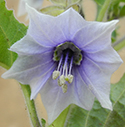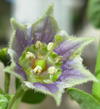front view |
|
habit |
flowers per
inflorescence |
corolla color |
corolla having 5 pairs of green spots |
Endemic
to Dept
Ancash |
common or rare in Dept Ancash? |
side view |
corona
? |
| |
|
shrub |
to 10 |
purple |
yes |
yes |
common in certain places, overall rare |
 |
no |
 |
J. sinuosa** |
shrub |
|
|
yes |
no |
|
 |
no |
 |
|
shrub |
5- to 7-flowered |
whitish with purple ring where tube meets limb |
yes
(not mentioned in the protologue!) |
yes |
|
|
no |
 |
|
shrub |
6- to 14-flowered |
limb dull olive green; narrow purple ring surrounding mouth of tube evident in photo |
yes |
yes |
|
|
no |
 |
|
herbaceous
(perennial?) |
1 |
purple
(brown and whitish green on one specimen) |
yes, visible in the photo |
no |
|
|
no |
 |
|
shrub |
2 - 4
(-6 including buds) |
green
|
no |
yes |
common |
|
no |
 |
|
shrub |
1, less commonly 2
(uncommonly to 3 with
one of these being a
flower and two being buds)
|
|
no |
yes |
|
|
no |
 |
|
shrub |
1 - 2 |
green |
no |
yes |
|
|
no |
| |
|
suffrutescent |
1, less commonly 2 |
green |
ring of darker green spots at the base of the corolla |
no |
rare |
|
yes |
 |
|
shrub |
3 - 8
(3 - 5 in protologue)
8 - 13
|
whitish with purple ring near petal's midlength |
yes, visible in the photo |
no |
|
|
no |
 |
|
shrub |
probably 4* |
whitish with purple ring where tube meets limb |
yes, visible in the photo |
yes |
|
|
no |
 |
|
shrub |
4- to 11-flowered |
purple with a pale green throat |
yes |
no |
|
|
no |
| |
species |
habit |
flowers per inflorescence |
corolla color |
corolla having 5 pairs of green spots |
Endemic
to Dept
Ancash |
|
|
corona
? |
|
|
|
|
|
|
|
|
|
|
| Plant Height |
to 2.3 m |
80 cm |
to 1.1 m |
20 cm |
to 2.3 m |
to 2 m |
|
0.8 m |
|
| Corolla Shape and Size (size when pressed) |
campanulate to rotate, 11.5 - 15.5 mm diam |
short-tubular with a spreading limb, the tube 1.6 X 4 mm at base, the limb11-14 mm diam. |
short-tubular with a reflexed limb. Tube 2 X 6.5-8 mm; limb 10.3 - 19.2 mm diam. |
broadly crateriform-rotate; to 3.7 cm across |
tubular with planar limb as shown above, 2 - 3 cm long |
campanulate to rotate, to 6 cm across |
|
short-tubular with a rotate limb |
|
| elevation (m) |
(2,958) 3,000 - 4,150 |
450 - 650 |
2,400 - 2,639 |
2,300 - 3,400 |
2,945 - 3,820 |
(3,000-)
3,400 - 3,800 |
|
2,450 - 2,750 |
|
Both pedicel and peduncle? |
|
yes |
yes |
no, single unarticulated axis |
yes |
yes |
|
yes |
|
| Hairs |
Young axes, peduncles, pedicels, leaves, and abax calyx puberulent with branchlet and finger hairs to 0.15 mm long. |
young axes, peduncles, pedicels, leaves and calyx nealy glabrous |
young exes, peduncles, pedicels, and abax calyx villous with erect, gland-tipped finger hairs to 3 mm |
soft, gland-tipped |
glabrate or sparsely hairy with non-gland-tipped finger and dendritic hairs |
glabrous
(except for base of filament and adax face of corolla) |
|
not gland-tipped, mostly finger but some have multiple termini |
|
|
 |
 |
 |
 |
 |
 |
 |
 |
 |
|
|
|
|
|
|
|
|
|
|
| Stamen Length (mm) |
2.8 - 3.9 |
5.5 - 6.5 |
7 |
6.9 - 7.2 mm |
26 - 36 |
19.5 - 24 |
|
|
|
| Filaments |
villous on proximal 1/5th |
villous on proximal 1/2 |
villous on proximal 4/5th |
filaments extremely villous at base |
villous on proximal 1/4th |
hairy on proximal 1/10th to 1/5th |
|
|
|
| Anther color |
cream |
no data |
cream |
drying brown
(or yellow if covered with pollen) |
blue to purple |
blue-purple |
yellow, |
purple or cream in nearby populations |
|
| nectar color |
clear |
no data |
clear |
clear |
clear |
red-orange |
red-orange |
clear |
|
| Fruit Color |
orange |
no data |
said to be orange |
probably orange |
orange |
orange |
orange |
orange |
|
| Fruit Eaten? |
no |
no data |
|
no data |
|
|
|
|
|
| Common? Rare? |
closer to common than rare |
rare |
locally common |
rare in department Ancash |
common |
uncommon to rare |
|
common |
|
|
 |
 |
 |
 |
|
 |
 |
 |
 |
|
|
|
|
|
|
|
|
|
|
| Synonyms |
none |
none |
none |
none |
Hebecladus bicolor (R. & P.) Miers.
H. biflorus (R. & P.) Miers.
H. intermedius Miers
H. weberbaueri Dammer |
Saracha weberbaueri Dammer
|
|
Hebecladus weberbaueri Bitter |
none |
| Sources |
|
|
|
|
|
|
fieldwork done May 2008 |
fieldwork by T. M., S. L. G. & L. Yacher |
fieldwork done May 2008 |
| in this table photo or illustration by |
T. Mione |
S. Leiva G. |
T. Mione |
T. Mione |
T. Mione |
T. Mione |
T. Mione |
T. Mione |
T. Mione |
| T. Mione, S. Leiva G. & Yacher collection numbers |
628, 629,
630, 723, 724 |
631 |
624, 729 |
616, 620,622 |
612, 617, 625, 627, 726, 728 |
626, 725 |
783, 790, 791 |
|
782 |
| Page Number in Brako and Zarucchi |
this sp. had not been described when I contributed to this work
|
this sp. had not been described when I contributed to this work |
this sp. had not been described when I contributed to this work |
this sp. had not been described when I contributed to this work |
page 1107 |
page 1108 |
page 1108, as a synonym of J. weberbaueri |
this sp. had not been described when I contributed to this work |
this sp. had not been described when I contributed to this work |
| Page Number(s) in Macbride 1962 |
this sp. was not described |
what is now the type specimen of this sp. was then considered to represent Saracha dentata on page 34 |
this sp. was not described |
this sp. was not described |
pages 30-31 as Hebecladus bicolor; page 35 as H. intermedius |
page 40 as Saracha weberbaueri |
page 40 as a synonym of Saracha weberbaueri |
this sp. was not described |
this sp. was not described |



